Today, more devices than ever are online. Stores use smart shelves and scanners, cities use sensors to manage traffic and energy, hospitals use remote health monitors, and even electric vehicle (EV) charging stations depend on a steady internet connection.
While connected devices allow businesses to grow, it also adds complexity. There are an estimated 18.8 billion connected devices in use today, and the number could grow to over 40 billion by 2030. That’s a lot of equipment to provision, protect, and keep running.
IT teams face numerous challenges if they don’t have the correct tools:
Individually activating a few devices is manageable, but activating thousands at one time can be challenging. Equipment setup typically requires provisioning of device settings, apps, rules and more. And if devices get shipped to remote sites, even small mistakes delay the process.
Every device needs updates to keep it performing properly and protected from cyber threats. Without OTA capability, IT staff have 2 options 1) send a technician to the location (“a truck roll”) or 2) recall the device. Both of these options take time, disrupt operations, and impact revenue.
To successfully manage remote devices, IT needs access to metrics such as data usage, signal strength, CPU health, failed updates, app crashes, and unusual behavior. Without this information, troubleshooting becomes difficult and time consuming.
Most companies must follow strict industry rules about data and security, or their own polices relating to data access. Without a digital tool that will adapt to new regulations and apply policies consistently, Errors are likely to occur, putting the network and data at risk.
Every connected device is a door into the network. Hackers look for weak passwords, old software, and open internet paths. In 2024, the average cost of a data breach was around $4.4 million.
With manual processes, growth becomes much harder without automation for provisioning, activation, kitting and shipping.
As businesses evaluate device and data management platforms, there are specific features that are essential and should be included in the overall solution.
Coverage varies by location, so it’s imperative that devices can switch between carriers automatically in order to avoid costly SIM swaps and site visits.
The ability to create profiles with the right OS version, apps, and settings that can be downloaded to thousands of devices at once is crucial. It’s also important to be able to apply policies by group so updates and rules stay consistent.
The solution should use private connections (such as private APNs or IPsec tunnels), so device traffic doesn’t travel over the open internet. There should also be an option to use web filters and firewalls to block risky sites and ports. This reduces the attack surface and protects against cyber threats.
The platform should collect data such as device connectivity, data usage, CPU, storage, app health, and error logs. It should also use AI and rule-based tools to identify alarming patterns and send email alerts so proactive steps can be taken before it turns into loss of productivity.
Kajeet Sentinel is an AI-enhanced, highly secure platform that allows organizations to remotely monitor and manage thousands of devices using an intuitive dashboard that allows companies to set policies, filter web traffic, monitor usage in real time, address problems remotely, and more.
Connected devices power business. But as fleets grow, so do the risks—security gaps, slow updates, unclear visibility, and costly downtime.
The solution is an intuitive, online device management platform that can be used to monitor and easily manage devices located anywhere in the country.


